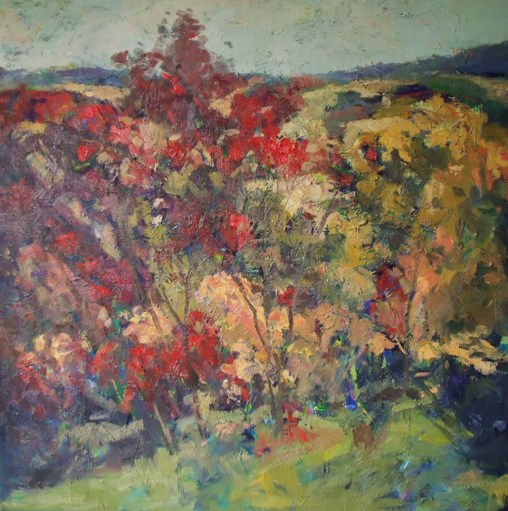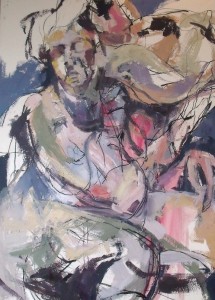In this ‘Spotlight’ interview, I’m talking to Rosalyn Mina, a talent in both paint and stained glass! Mina’s work is stunning and her passion for her art shines through in this honest, passioned and enthusiastic revelation of her career. Enjoy!
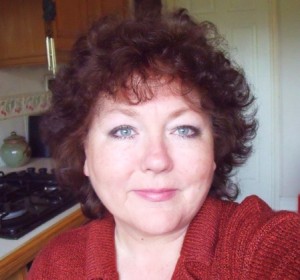
How and when did you start out as an artist? Had you always wanted to do art?
I have drawn and painted as far back as I can remember. As a young child I was very fortunate to be encouraged at primary school and had a wonderful art teacher, Jim Sherridan, at high school who encouraged me to go to art college. I went on to do a Graphics Degree at Leicester Polytechnic, specialising in Illustation.
How did you first get into stained glass; had you planned to do this all along or was it just an opportunity that arose?
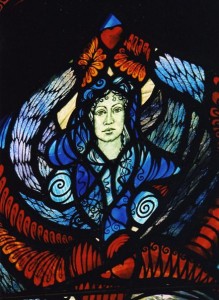
I became interested in stained glass during my final year at Leicester, after coming across a book in the college library on post-second world war stained glass in Germany.I had never seen anything like it before and saw immediate connections with the linear drawings I was working on at the time. The windows of Ludwig Schaffrath were particularly inspiring; very linear with limited colour – some with clear glass which accentuated the linear element – and I found that really exciting. This led me to visiting the post-war stained glass collection at Coventry Cathedral and I was incredibly moved by the scale and the luminosity of the coloured glass. I managed to convince my tutors at college to allow me to do my final project on stained glass as a form of illustration and that was the start of my passion for stained glass.
What training did you have for your stained glass work? Was it easy to learn?
After leaving college I embarked on finding a stained glass apprenticeship and after writing many letters and having many interviews I was finally invited to be trainee apprentice to Lawrence Lee in Penshurst, Kent. I was very new to the craft, so did not really know much about who was who, etc. It was after working with Lawrence for a few weeks that I discovered he in fact had windows in Coventry Catherdal and had managed the stained glass installation for the entire cathedral. I was quite taken aback; fate had led me to Coventry and then on to work with one of the artists whose windows had inspired me so much. I felt really privileged to be working with him. I was thrown in at the deep end, which was quite scary, but a wonderful way to learn. I worked with him on many of his windows and learned to do all aspects of stained glass, from scaling up full size drawings to cutting, painting, firing and leading. I also worked on a medieval copy of ‘St. Anne Teaching Mary the Scriptures’ and under Lawrence’s guidance, this became my very first traditional stained glass panel. From there I went on to work in the design departmant of Goddard and Gibbs in London, where we worked on many stained glass domes for palaces in the Middle East. It was a great experience and wonderful to work on such a vast scale, but the design side was very limiting and I decided to go freelance.
Is there a high demand for stained glass these days? How do you advertise it besides your website?
I was very fortunate to have worked with Opus Stained Glass as a freelance designer for new commissions and worked with them on many windows in the South East.
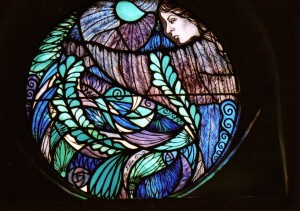
I am happy to say that recommendation has brought me new commissions from that, so I have never actually advertised. Unfortunately, the current financial situation has hit the stained glass industry quite hard, but hopefully things will improve. On the positive side, I have been able to focus and develop my painting.
How long does a stained glass piece take you to complete, from design to the finished product? Is it a costly process?
The time scale depends on the size and detail of the design, as does the cost. Some have taken me nearly a year to complete from start to finish; others a few months. On average, a church window could cost from £3,000 for a small window upwards to around £25,000 or more. The cost is broken down into design time, drawing up the cartoon full-size, cutting, painting & firing, leading and installation. Of course, the glass itself can be expensive, especially if using hand-made antique glass, but usually a mix of antique and machine-made is used. Mistakes are not really an issue; it is a craft involving many processes, so providing one is methodical during each stage, mistakes can be avoided. I guess pieces could accidentally get broken after leading, but it always possible to rectify.
What do you love about doing stained glass and are there any downsides?
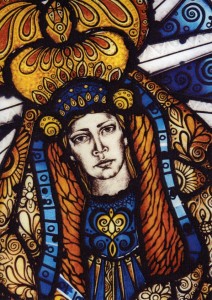
I love the transformation from the design on paper into a window of luminous coloured light. It is an act of faith and patience too, for it is not until it is installed that one gets to see the finished article. I love each stage of the process, building it up bit by bit and seeing it evolve through the various stages. It is incredibly satisfying and is quite physical which I really enjoy; a real craft. I really can’t think of any downsides, except that I still manage to cut myself on the glass when cutting!
Moving onto your paintings; your abstract landscapes are very striking! How did you develop your style with these?
I am enjoying the development of my semi-abstract landscapes. It is an ongoing process and feels like the possibilities are endless. I did a workshop one summer a few years back which included drawing and painting on the South Downs, then working with the sketches back at the studio. It was a whole new experience having to rely on memory as well as the sketches. We were encouraged to remember what we felt about the space too and to try and capture that in paint. I was made aware of how we get into the habit of making the same kind of mark over and over, and so I set out to de-programme myself and start creating ” new ” marks. I found by looking at my sketches there were certain marks and shapes that seemed to capture the essence of the landscape, so I simply used those as a starting point, sometimes distorting or changing the scale and took it from there. It is quite hard to put into words, but in essence it is like deconstructing and putting back together again in a way that expresses not just the features of the land, but the atmosphere and space too. The outcome is a semi-abstract impression, created with a personal visual lauguage of markmaking and colour. I still enjoy “traditional” landscape painting as works of observation and I can see the development in my mark-making in these works too which is more lively and vibrant. The interesting thing is that they become studies for future abstrasct works, so I gain from doing both.
You use a variety of materials to produce your art; which is your favourite to use and why?
That is a difficult question to answer, as I enjoy both. I love acrylic as it dries quickly and allows for over-printing. I also enjoy the soft, pliable quality of oil paint, especially when working on paper or cardboard, as it allows for more and quicker over-painting as it is absorbed into the surface. I have recently been experiemnting with mono-printing using oil paint and printing onto ink drawings; the results are exciting and I will be developing this further.
Who is your artistic inspiration (or inspirations, should you have more than one!)
I have many and it is a joy to be constantly discovering more. Barbara Rae is a real inspiration with her luminous colours and contrasting textures. Rob Newton is too, for his bold, confident brushwork and beautiful muted tones and Alan Rankle with his amazing ability to translate the landscape into mysterious atmospheres of dramatic shape and colour. Gillian Ayres is another favourite, I remember watching her being interviewed and she said how much she enjoyed the process of painting; I think that comes across very strongly in her works – they exude joy on every level, painting for the sheer joy of painting.
What is your favourite painting (that you’ve created!)
I dont really have a particular favourite, although I remember feeling very happy with ‘SouthDowns’, which was my first semi-abstract. Usually I am quite pleased with whatever I am working on once I get it through the “tricky stage” which every painting goes through and it is very satisfying when the painting feels complete. I guess one’s favourite painting is always the last best one, soon replaced by another idea and the start of a new painting and so it goes on. There are times when a painting seems to flow and results come very quickly. I find it is usually when one lets go allowing happy accidents to take place; these are usually exciting works and I remember feling that when I painted ‘Ahrodite and Hephestus’.
You teach A-Level art; how does this influence your work?
I view teaching as a vital element in the development of my own practice. It is a fertile, creative environment and ideas materialise, whether it be through discussion or experimentation, not forgetting direct inspiration form the work of the students. One idea leads to another and so it goes on. It is an incredibly rewarding job and I have had some very talented students. There is nothing more rewarding than helping someone to discover their creativity; it can be a struggle, but when they get there, it is a real joy.
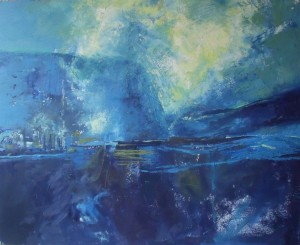
I believe we are all creative beings; it is a fundamental human necessity and when that desire is fulfilled, whether it be painting, writing, music or even gardening etc, we become much more fulfilled in our lives. I teach part-time giving me the time for my own work. It is a lovely balance and I feel very fortunate to be able to do this.
Any tips to other artists out there on how to get your work seen and get the commissions coming in?
I think having regular exhibitions is a great way to get your work seen, to get commissions and to generate word of mouth. Displaying work on a web-site like The Artists Web is also a great way to promote one’s work.
What do you love most about beingan artist? Would you ever want to do anything else?
I love the fact that it is a continuous journey of discovery and development, and I realise more and more how important it is to let go and see what happens, almost like playing.
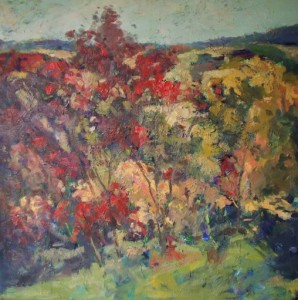
It is definately a state of mind and I try to treat everything as an experiment, which is a good way to lessen the pressure and be open to endless possibilities. So I guess I really love not knowing what is going to happen next and to be open to receive those precious happy accidents.
I’d like to thank Rosalyn for her time and generosity in sharing so much about her work and inspirations with us. You can see more of her beautiful creations, both in stained glass and in paint, on her website:

